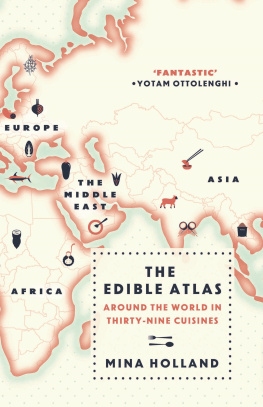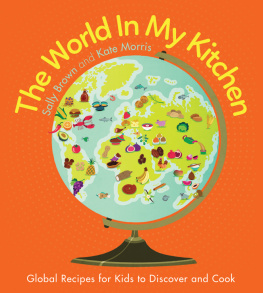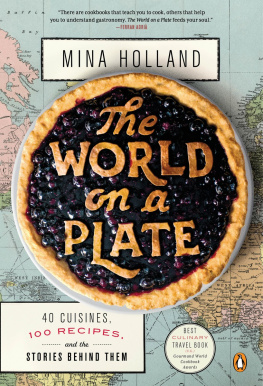CONTENTS







First published in Great Britain in 2014 by Canongate Books Ltd,
14 High Street, Edinburgh EH1 1TE
www.canongate.tv
Copyright Mina Holland, 2014
Maps Liane Payne
The moral right of the author has been asserted
For permission credits, please see
British Library Cataloguing-in-Publication Data
A catalogue record for this book is available on
request from the British Library
ISBN 9780857868558
eISBN 9780857868565
Editor: Jenny Lord
Art direction and design: Rafaela Romaya
Symbols: Peter Adlington
FOR MY GRANDMOTHERS
PIMENTN

Pimentn is the smoked paprika flavour that is often seen to define Spanish food. People often know it as a taste rather than an ingredient. London-based chef, food writer and restaurateur Jos Pizarro told me hed been accused of feeding vegetarians chorizo in the past, when in fact what they could taste was a sprinkle of pimentn in a meat-free dish. It is a fine, deep red powder that is often dusted over dishes like pulpo a la Gallega just before serving, leaving little red flecks over the boiled octopus and potatoes. Pimentn is also a key ingredient of many national dishes like cocido stews and chorizo, where it is responsible for the red colour and strong, smoky notes. Pimentn is made in both Murcia and Extremadura (in the south) by drying out capsicum peppers in industrial chambers before being milled to make the smoky dust. Capsicum peppers first came into Spain with Christopher Columbus in the sixteenth century, who returned from his New World adventures with a handful of ingredients including the potatoes and tomatoes that would change Spanish food irreversibly. Pimentn comes in different varieties from sweet through to spicy, though always with smoky notes; this smokiness is particularly intense in pimentn de la Vera, the Extremaduran DOC (denomination of origin).
This is a must-have larder ingredient if youre interested in making Spanish food it is prevalent all across Spain with the exception of Catalonia (see ). My cupboard is never without a tin of pimentn, either to sprinkle over a Spanish creation or to embellish simple soups, ham or cheese with some smoky oomph.
SALT COD
Salt cod or bacalhau is made with Atlantic cod (and, more recently, other varieties of white fish such as pollock and whiting). The fish is gutted and laid flat, then salted and dried to create a crispy shell that preserves the product for a couple of years, making it both a practical and economical source of protein. Salt cod needs to be soaked and boiled to rehydrate it before cooking.
Although salt cod is most commonly associated with the cuisine of Portugal, it is in fact native to North Atlantic countries like Norway, Iceland and parts of Canada. Bacalhau is so important in Portuguese cuisine, however, where it has thousands of uses including fritters (bolinhos), bacalhau Minhota (salt cod fried with potatoes, onions and paprika, from the northern region of Minho), and bacalhau Gomes de S (a casserole of potatoes, eggs, olives and salt cod) that it seems remiss not to include it here. It is also plays an important role in other cuisines of the Mediterranean including that of Spain (see Nieves recipe for buuelos de bacalao on
Salt cod has been an important point of trade between the Old and New Worlds. While many of the ingredients which are now integral to European cuisines originated in the New World from rice to spice, chillies, potatoes and tomatoes on the flipside, European salt cod has become essential to cuisines of West Africa and the Americas, for dishes eaten perennially and ubiquitously (like ackee and saltfish see ). It features heavily in the cuisines of former Portuguese colonies like Brazil, the Philippines, Macau and Goa.
. Russell Norman purportedly gave Florence knight her job as head chef at his acclaimed Soho restaurant Polpetto on the basis of her ability to make the famously tricky Venetian dish, baccal mantecato salt cod poached with milk, onions and bay then whipped into a mousse.
RICE
Rice is thought to have originated in China many thousands of years ago and is now in the running for the title of worlds most important foodstuff, feeding millions across the globe. The only crop grown more prolifically is corn (see ), but while rice is grown mainly for human consumption, corn is often intended for other purposes, like fuel.
Rice is a staple in cuisines across the world, from the sticky versions enjoyed perennially in East Asia to the jollof rice of West Africa (), risottos of Italy, chelo of Iran and pilafs and pilau of Turkey and India respectively.
As a crop it is remarkably versatile and can grow in myriad conditions, although the plant needs a lot of water and thrives in the paddy environment famous in East and South-East Asia. Fields of young rice plants are flooded, allowing them to flourish in the abundance of water while keeping pests to a minimum. On harvesting, husks are removed from the grains this makes for brown rice, which can be further milled to create white rice. Though its nutritional value is inferior, white rice can be stored for a long time and is a simpler, quicker ingredient to cook with and thus a sustainable and easy food solution for people across the world who have only rudimentary cooking equipment.
In its native China, rice is one of the Twelve Symbols of Sovereignty a symbolic interpretation of the universe that bolstered the emperors self-image as second only to God. Rice represented his ability to feed his people, a symbol of fertility and prosperity.
Next page












